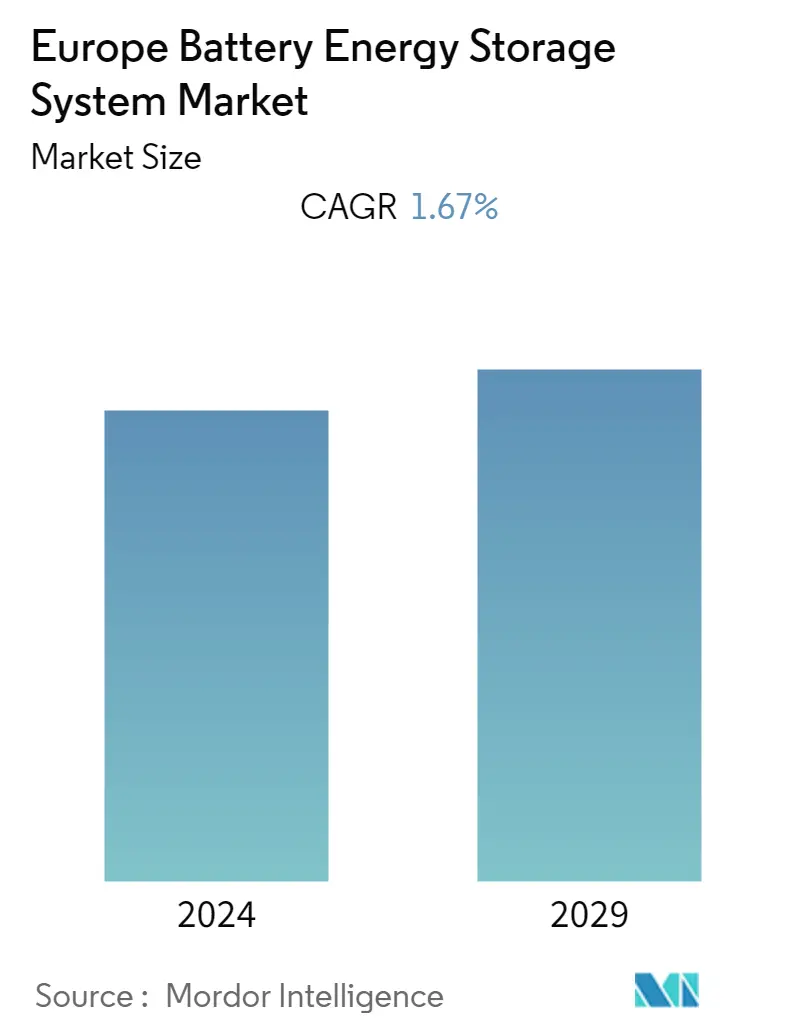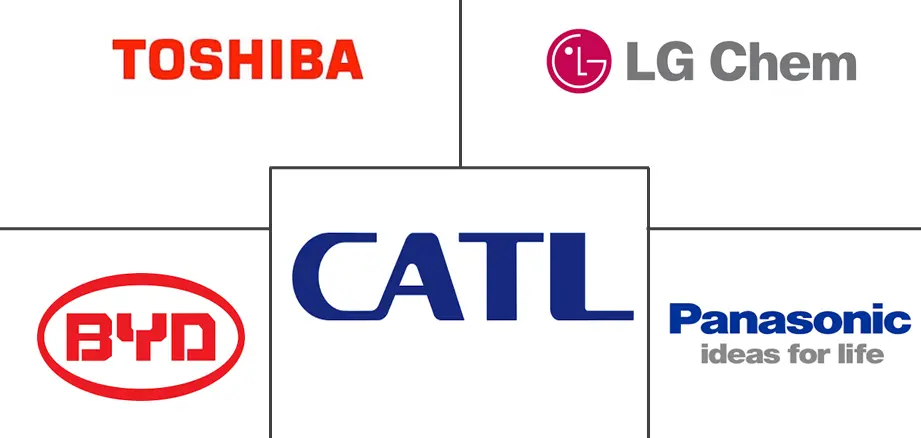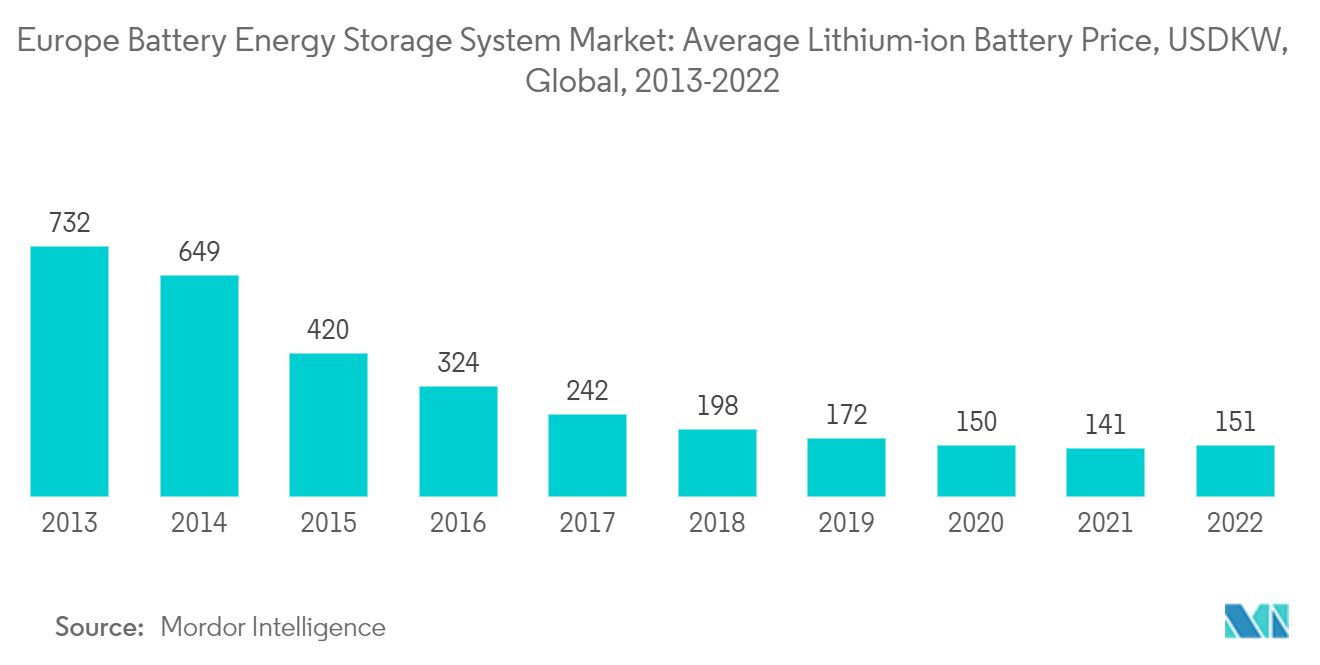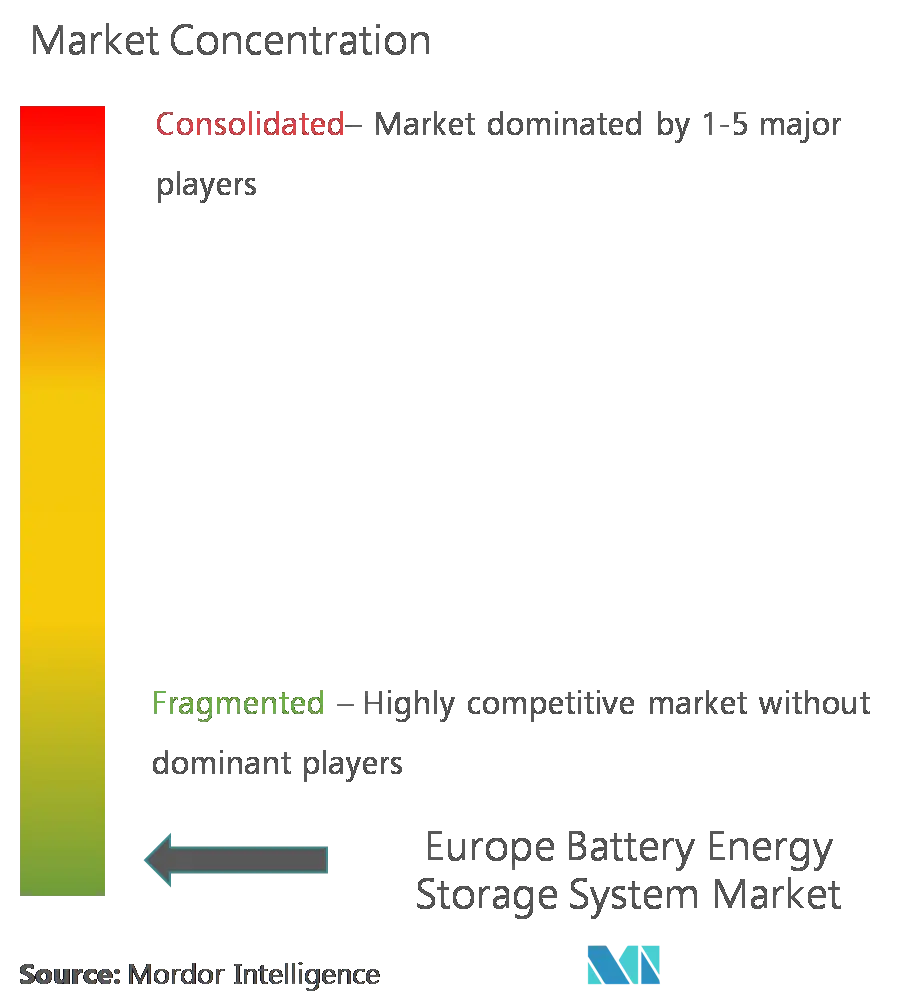Europe Battery Energy Storage System Market Size

| Study Period | 2019 - 2029 |
| Base Year For Estimation | 2023 |
| Forecast Data Period | 2024 - 2029 |
| Historical Data Period | 2019 - 2022 |
| CAGR | 1.67 % |
| Market Concentration | Low |
Major Players
*Disclaimer: Major Players sorted in no particular order |
Europe Battery Energy Storage System Market Analysis
The Europe Battery Energy Storage System Market size is expected to grow from USD 11.10 billion in 2023 to USD 12.05 billion by 2028, at a CAGR of 1.67% during the forecast period (2023-2028).
- Factors such as increasing demand for uninterrupted power supply during the peak hours of the day when battery energy storage systems serve as a backup is likely going to drive the European battery energy storage system market.
- On the other hand, the mismatch in the demand and supply of the raw materials used for battery manufacturing is expected to restrain the market during the forecast period.
- New generation batteries, such as lithium-sulfur and solid-state, due to technological improvements such as an increase in efficiency and production scale-up, are expected to take over the market by 2030 or 2035. These advancements in batteries are expected to create several opportunities for the European battery energy storage market in the future.
Europe Battery Energy Storage System Market Trends
Lithium-ion Segment Expected to Dominate the Market
- Lithium-ion batteries are a rechargeable type of cell that is commonly used in electronic devices and energy vehicles. These batteries are also being used for renewable energy storage from sources such as solar and wind. The energy densities of these batteries are quite high, and they have a round-trip efficiency of 85% to 95%. The lithium-ion battery is a low-maintenance battery, and the cells of the battery cause little harm to the environment when disposed of.
- Further, the global lithium-ion battery manufacturers are focusing on reducing the cost of Li-ion batteries. The price of lithium-ion batteries declined steeply over the past ten years.
- However, in 2022, the battery prices had slightly increased to reach USD 151/KWh (witnessing a 7% increase over the previous year) owing to the increasing average battery pack prices of electric vehicles and energy storage systems. The prices are expected to reach USD 152/KWh in 2023; however, it is projected to dip again from 2024, when lithium prices are expected to ease as more extraction and refining capacity comes online and reaches USD 100/kWh by 2026.
- Lithium-ion batteries have significance in battery storage systems as they are used in solar, wind, and other battery energy storage systems. As per the REPowerEU plan, the region has planned to bring total renewable energy generation capacities to 1,236 GW by 2030. This is expected to create opportunities for battery energy storage systems as well.
- The installation of renewable energy is rising significantly in Europe, as the region has targeted becoming carbon neutral by 2050. For instance, the region installed around 41 GW of new solar capacity in 2022, which was 47% higher than the 28 GW added in 2021. Renewable energy sources such as solar, wind, geothermal, and others rely on lithium-ion batteries for energy storage systems.
- Moreover, countries in Europe have set targets to install renewable energy in their respective countries. With growing concerns regarding air pollution, many countries in the region have launched several policies and subsidies in the renewable energy market. As renewable energy is an intermittent energy source, the extra power generated by it can be stored in a battery storage system for later use. This is likely going to drive the market during the forecast period.
- Solar panels produce low-resistance charging, and lithium batteries require this. In addition, these batteries also charge quickly, which further allows the end users to maximize the potential energy storage of solar power for each minute of available sunlight.
- In October 2022, Nanotech Energy Europe BV announced that it signed a purchase agreement to supply more than 1 GWh of battery energy storage systems through 2028 to Smile Energy in Athens, Greece. This system would comprise Nanotech's graphene lithium-ion battery, and this project is crucial for Nanotech to expand its energy storage business in Greece for solar infrastructure.
- The adoption of Li-ion batteries has been increasing, primarily due to their property of being the most energetic rechargeable batteries available. In addition, the use of Li-ion batteries is increasing as they are replacing conventional batteries due to their techno-economic benefits.
- Hence, owing to the above points, the lithium-ion segment is likely to dominate the European battery energy storage system market during the forecast period.

Germany Expected to Dominate the Market
- According to the European Association of Energy Storage (EASE), Europe requires about 187 GW of energy storage by 2030, of which battery storage accounts for 122 GW of capacity. It signifies countries like Germany's rapid development of battery storage solutions to secure energy supplies to help overcome the after-effects of the Russia-Ukraine war-led energy crisis.
- Hence, with ambitious targets and a global trend to adopt a clean source of electricity, battery energy storage systems appear as a feasible option to power residential, commercial, and industrial (C&I) and utility-scale applications, enhancing renewable energy integration in the country.
- The federal government is making PV battery system investment very attractive by providing unique incentives, including low-interest loans and investment grants.
- For instance, the Government of Germany launched the KfW Renewable Energy Programme-Storage, which provides low-interest loans for stationary battery storage systems related to a PV installation. The investment addressed either setting up a new PV installation along with a battery storage system or only the financing of a battery storage system related to a PV installation that was put into operation after 2012. Only one storage system for each PV installation is eligible for the support scheme, and additionally, the PV installation, along with the battery storage system, is allowed to have an installed capacity of a maximum of 30 kWp.
- Moreover, with the increased decentralization of electrical systems such as rooftop solar energy in Germany, the installation of residential PV batteries has gained traction. Electricity utilities have devised attractive tariffs and service models, such as flat electricity rates for PV batteries. It facilitated the expansion of battery energy storage systems on the market.
- Therefore, such government initiatives are likely to increase demand for energy storage systems in Germany.

Europe Battery Energy Storage System Industry Overview
The European battery energy storage system market is fragmented. Some of the key players in this market (in no particular order) include BYD Company Ltd., Contemporary Amperex Technology Co Ltd., Panasonic Corporation, Toshiba Corp., and LG Chem Ltd.
Europe Battery Energy Storage System Market Leaders
-
Toshiba Corp
-
BYD Company Ltd
-
Contemporary Amperex Technology Co Ltd-
-
Panasonic Corporation
-
LG Chem Ltd
*Disclaimer: Major Players sorted in no particular order

Europe Battery Energy Storage System Market News
- February 2023: Power & Air Solutions, the Deutsche Telekom subsidiary, completed its first battery energy storage system (BESS) installation supplied by Pixii. The storage system was installed at one of Deutsche Telekom's main offices in Munich, Germany. The installation in Munich has 1 MW of conversion capacity and 6 MWh of storage capacity.
- November 2022: RWE announced plans to build a storage facility to provide grid-balancing services for its power plants in Germany. The company aimed to install a total of 220 MW of battery storage capacity at two RWE power plants in North Rhine-Westphalia for about USD 139.9 million. Construction was scheduled for 2023, and operations are expected to commence in 2024. The Hamm, Germany, site will have 140 MW of battery power. It was expected to occupy an area of 14,000 square meters. In Neurath, another facility would have 80 MW of power and occupy an area of 7,000 square meters.
Europe Battery Energy Storage System Market Report - Table of Contents
1. INTRODUCTION
- 1.1 Scope of the Study
- 1.2 Market Definition
- 1.3 Study Assumptions
2. EXECUTIVE SUMMARY
3. RESEARCH METHODOLOGY
4. MARKET OVERVIEW
- 4.1 Introduction
- 4.2 Market Size and Demand Forecast in USD, till 2028
- 4.3 Recent Trends and Developments
- 4.4 Government Policies and Regulations
-
4.5 Market Dynamics
- 4.5.1 Drivers
- 4.5.1.1 Increase in Adoption of Renewable Energy
- 4.5.1.2 Declining Cost of Lithium Ion Battery
- 4.5.2 Restraints
- 4.5.2.1 Shift Towards Other Energy Storage Systems
- 4.6 Supply Chain Analysis
-
4.7 Porter's Five Forces Analysis
- 4.7.1 Bargaining Power of Suppliers
- 4.7.2 Bargaining Power of Consumers
- 4.7.3 Threat of New Entrants
- 4.7.4 Threat of Substitute Products and Services
- 4.7.5 Intensity of Competitive Rivalry
5. MARKET SEGMENTATION
-
5.1 Battery Type
- 5.1.1 Lithium-ion Battery
- 5.1.2 Lead-acid Battery
- 5.1.3 Flow Battery
- 5.1.4 Other Battery Types
-
5.2 Application
- 5.2.1 Utility
- 5.2.2 Residential
- 5.2.3 Commercial and Industrial
-
5.3 Geography
- 5.3.1 Germany
- 5.3.2 United Kingdom
- 5.3.3 France
- 5.3.4 Rest of the Europe
6. COMPETITIVE LANDSCAPE
- 6.1 Mergers, Acquisitions, Collaboration and Joint Ventures
- 6.2 Strategies Adopted by Key Players
-
6.3 Company Profiles
- 6.3.1 BYD Company Ltd.
- 6.3.2 Tesla Inc
- 6.3.3 Contemporary Amperex Technology Co Ltd.
- 6.3.4 Panasonic Corporation
- 6.3.5 Murata Manufacturing Co., Ltd.
- 6.3.6 Leclanché SA
- 6.3.7 LG Chem Ltd.
- 6.3.8 Samsung SDI Co Ltd.
- 6.3.9 Toshiba Corp
- 6.3.10 Wartsila Oyj Abp
- *List Not Exhaustive
7. MARKET OPPORTUNITIES AND FUTURE TRENDS
- 7.1 Technological Advancements in Battery Technology
Europe Battery Energy Storage System Industry Segmentation
Battery energy storage is considered a critical technology in the transition to a sustainable energy system. The battery energy storage systems regulate voltage and frequency, reduce peak demand charges, integrate renewable sources, and provide a backup power supply. Batteries play a crucial role in energy storage systems and are responsible for around 60% of the system's total cost.
The European battery energy storage market is segmented by battery type (lithium-ion, lead-acid, flow, and others), application (residential, commercial, and industrial), and geography (the United Kingdom, Germany, France, and the rest of Europe). The report offers the market size and forecasts for Europe's battery energy storage market for all the above segments.
| Battery Type | Lithium-ion Battery |
| Lead-acid Battery | |
| Flow Battery | |
| Other Battery Types | |
| Application | Utility |
| Residential | |
| Commercial and Industrial | |
| Geography | Germany |
| United Kingdom | |
| France | |
| Rest of the Europe |
Europe Battery Energy Storage System Market Research FAQs
What is the current Europe Battery Energy Storage System Market size?
The Europe Battery Energy Storage System Market is projected to register a CAGR of 1.67% during the forecast period (2024-2029)
Who are the key players in Europe Battery Energy Storage System Market?
Toshiba Corp, BYD Company Ltd , Contemporary Amperex Technology Co Ltd-, Panasonic Corporation and LG Chem Ltd are the major companies operating in the Europe Battery Energy Storage System Market.
What years does this Europe Battery Energy Storage System Market cover?
The report covers the Europe Battery Energy Storage System Market historical market size for years: 2019, 2020, 2021, 2022 and 2023. The report also forecasts the Europe Battery Energy Storage System Market size for years: 2024, 2025, 2026, 2027, 2028 and 2029.
Which battery type segment dominates the Europe BESS Market?
Based on battery type Lithium-ion segment dominates the Europe BESS Market.
Europe Battery Energy Storage System Industry Report
The European Battery Energy Storage System (BESS) market is experiencing significant growth, driven by the increasing integration of renewable energy sources and the need for grid stability. Dominated by lithium-ion batteries due to their high energy density, efficiency, and longer lifespan, these batteries are the preferred choice for applications including renewable energy integration and grid stabilization. The market is segmented by battery type, with lithium-ion leading, followed by lead-acid, flow, and other types. The residential sector generates significant revenue, driven by the rising demand for reliable and sustainable energy solutions in homes, benefiting from the adoption of energy storage systems for backup power, load shifting, and integration with solar panels. Geographically, the market shows diverse dynamics across countries, each reflecting a combination of national energy policies, renewable energy goals, and grid infrastructure developments. The Europe battery energy storage systems market size and market share are characterized by continuous advancements in battery technology and supportive policies from governments, crucial for the widespread adoption of energy storage solutions. For detailed statistics, market share, size, and revenue growth rate, refer to industry reports by Mordor Intelligence™, which include market forecast outlooks and historical overviews, available as free report PDF downloads.



